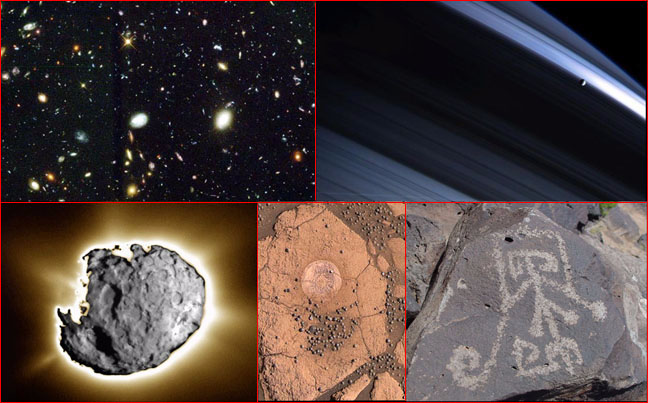|
|
||
 Credits (left to right): . HDF Team/NASA • Cassini Imaging Team/SSI/JPL/ESA/NASA • Stardust Team/JPL/NASA • Mars Exploration Rover Mission/JPL/NASA • Anthony Peratt |
||
|
pic of the day Links:
Society for
|
Dec 23, 2004 Nothing is more essential to a new vantage point in the sciences than the power of prediction. And nothing tests predictive ability more fiercely than new discoveries, as space probes expand our view of the solar system and the larger universe. The space age has not been friendly to scientific orthodoxy. Our telescopes and probes have produced far more surprises than confirmations. Surprises are the first indication that we are not seeing the world accurately. Before the discovery of magnetic fields in space, astronomers did not expect them. Magnetic fields are the signature of electric currents, but few could imagine electricity acting across the “vacuum” between planets or between stars. The surprises of the space age are pointers that must not be ignored. These pointers are not chaotic. They speak for more unified possibilities, for a new vantage point from which the surprises are PREDICTABLE: acceleration of the solar wind; x-rays from comets, inexplicable crater chains on planets, moons, and asteroids; super-heated “volcanoes” on Io, the hourglass formations of nebulas; quasars physically connected to the closest galaxies. In such instances and a hundred more, the moment of discovery provoked exclamations of great surprise. The scientists in charge were looking for something else! It is time, therefore, to begin testing the predictive ability of a new perspective, one based on the powerful electric force in the universe. Accordingly, we shall devote our last five pictures of the day for this year (December 27-31) to anticipating paths of discovery in 2005. The headings will be-- • Decline of the Big Bang hypothesis • Role of electricity in the Saturnian system • The electric comet (and what it can tell us about the Sun) • Electrical scarring of planets and moons • Plasma discharge configurations in the ancient sky We invite our readers to consider these pages as they appear and to observe the course of scientific exploration in 2005. Watch particularly for a cascade of surprises, with an eye to issues of theory and prediction.
|
|
|
Copyright 2004: thunderbolts.info |
||
